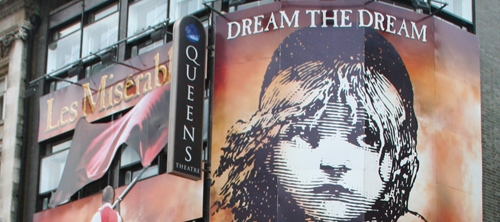
Sondheim Theatre
Londres - Angleterre
Construction: 1907
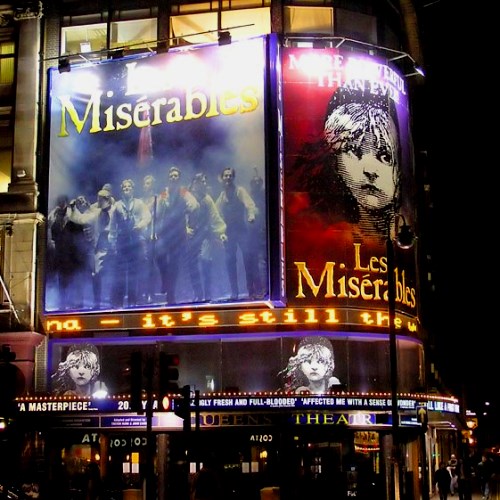
Topologie du théâtre
Nombre de salles actives: 1
Salle 1: (990) 1907 - Actif
Accès
En métro: Picadilly Circus/Leicester Square
En bus: 14, 19, 22B, 38, 53, 88, 94, 159
Adresse: Shaftesbury Avenue
Evolution
Bâtiment: 1907. Designed by W. G. R. Sprague and opened on 8 October / 1940. Bombed and badly damaged in air raid of 24 September / 1959. Reopened following rebuilding and remodelling / Statutorily Listed Historic Building: Grade II.
Nom:
Propriétaire(s)
Delfont Mackintosh Theatres
Remarquable
Rebuilt front of house by Bryan Westwood of Westwood Sons and Partners in consultation with Sir Hugh Casson

990
1907 - Actif
On Tuesday, 24 September 1940, 110 enemy aircraft carried out a night raid on London, dropping large numbers of incendiary bombs, mainly north of the River Thames. Although the attack was somewhat random, the Queen's was hit by a high explosive device that destroyed the front of house, and with it W. G. R. Sprague's fine, almost symmetrical, Edwardian Renaissance composition that mirrored the Gielgud (formerly the Globe) to its south. A photograph hanging in the present foyer shows a Corinthian-columned vestibule with an impressive geometrical Imperial staircase. It may be that one day the loss will be rectified, perhaps with the help of Arts Council or National Lottery funding.
It was not until 1957 that the work of rebuilding and remodelling commenced, the scheme being designed by architect Bryan Westwood of Westwood, Sons and Partners in consultation with Sir Hugh Casson, who had been Director of Architecture for the 1951 Festival of Britain. The new work clearly reflects the spirit of its age: a five-storey curving curtain-wall structure, in a commercial grey- blue brick and casement-wlndow office style. The foyer, stalls and circle bars, with their deeply reeded walls and dark wood, are spacious extensions of the mid-1950s street architecture, as is the grand staircase with Its enormous timber handrail. The theatre was reopened on 8 July 1959 by John Gielgud in a Shakespearean recital, The Seven Ages of Man. Externally, the long, red-brick, 12-bay flank elevation overlooks the remains of St Anne's Church (1686), also bombed In 1940 and probably designed by William Talman, who later worked at Burghley House, Stamford, and Chatsworth, Derbyshire.
Just as at the Lyric Theatre, Hammersmith, in west London, where modem offices encase Frank Matcham's reslted and elevated auditorium, so at the Queen’s the magic of the auditorium is enhanced by the contrast with the pared-down architecture of the late 1950s. Sprague’s Interior, which survived the bombing almost undamaged, Is a controlled, exquisite composition in what was described as the Old Italian Renaissance style, Incorporating two cantllevered balconies decorated in an Adamesque manner, and three tiers of boxes either side of a rectangular framed proscenium. The more baroque saucer-domed celling has four semicircular lunettes, each adorned with pairs of seated muses. The decorative scheme when the theatre opened on 8 October 1907 was cream and gold, and these colours predominate In the auditorium over a century later. Skeletal remains of original timber stage machinery are extant in a single corner trap, a grave trap and an upstage bridge.
J. E. Vedrenne, the first lessee, named his theatre after Queen Alexandra. The first production was Madeline Ryley’s The Sugar Bowl, followed more successfully by The Devil’s Disciple. Other successes followed, including Potash and Per/mutter (1914), The Apple Cart (1929, with Cedric Hardwlcke and Edith Evans), Private Lives (1972), and Les Misérables (2004).
1907. Designed by W. G. R. Sprague and opened on 8 October / 1940. Bombed and badly damaged in air raid of 24 September / 1959. Reopened following rebuilding and remodelling / Statutorily Listed Historic Building: Grade II.
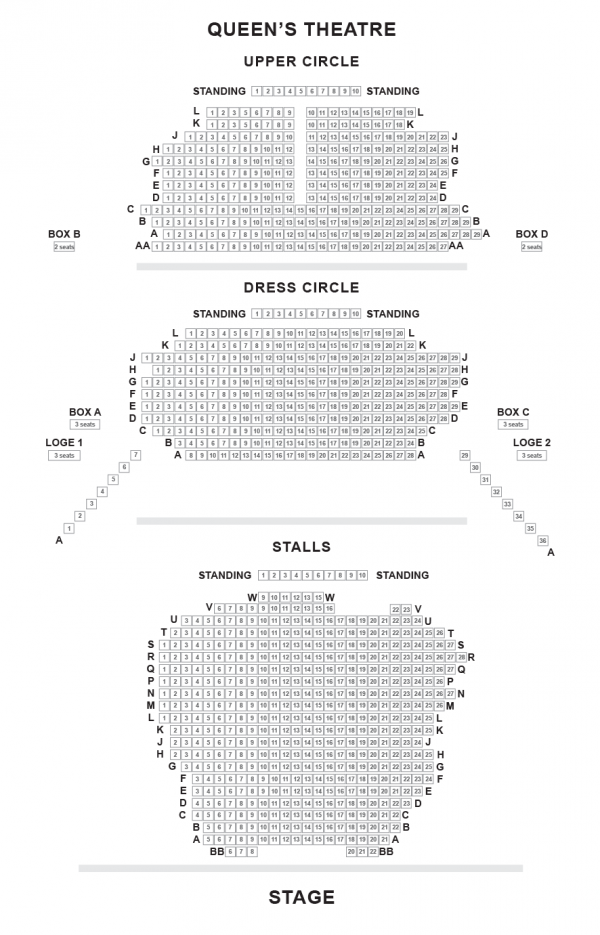
Infos complémentaires:
The stalls are below street level and feel rather dungeon-like due to the heavy overhang and lack of division. Sitting as one large body of seats it is easy to feel claustrophobic and distant from the action on-stage Most seats in this area are priced the same, which does not fully reflect the variation in seat quality. Sitting close to the action provides an intense and gripping experience and even seats on the end of rows from row A to J offer the best value for money in this section.
The overhang of the Dress Circle significantly reduces the seat quality of those seats in the back half of the auditorium, but seats towards the centre of each row should be selected first. The section is not significantly raked and so you are aware of the audience in front of you at all times, rather than focused on the drama on-stage Leg room is sufficient in most rows and the seats themselves are relatively comfortable.
The Dress Circle offers the most consistent views of the stage and is better value for money than the Stalls overall. Again the section is undivided by an aisle so those who want extra legroom need to pitch for the ends of the rows, where views of the stage are not as good due to the curve of the theatre. Dress Circle Lodge seats are available and run as slips along the side of the auditorium, but are priced as restricted view. To avoid the overhang aim to sit as close to the front as possible to get full value for money.
A number of seats towards the front sides of the Dress Circle are labelled restricted view but offer a good way to see the show at a discounted rate. Although some areas of the show may be obstructed, you will feel ultimately more involved than in other seats further back for the same price. One advantage of sitting further back in the Dress Circle is that the larger ensemble scenes and Barricade scenery are easier to view, giving those who have perhaps seen the show before a fuller appreciation of the scale, substituting some detail.
The Upper Circle is similar in size to the Dress Circle, although has a half aisle in the centre. A significant number of seats are offered at a reduced price as they are restricted view due to the shape of the section. Whilst not to be necessarily avoided, obstructions vary depending on which section you book.
Rebuilt front of house by Bryan Westwood of Westwood Sons and Partners in consultation with Sir Hugh Casson
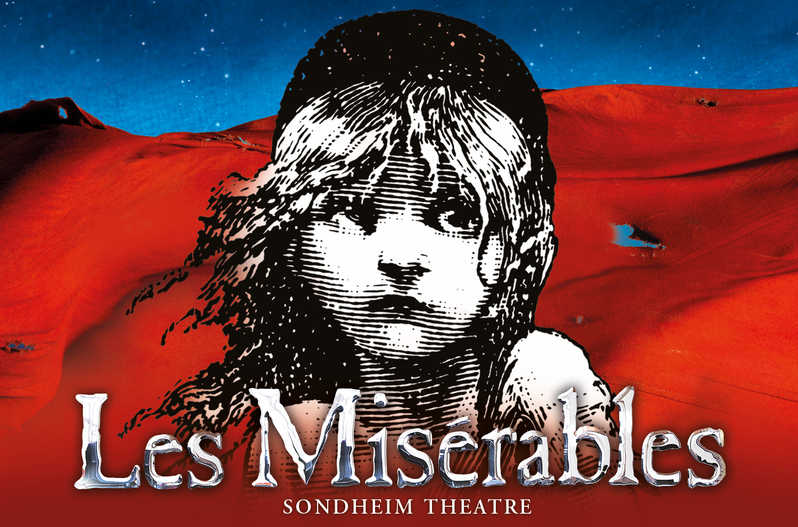
Musical
Revival
1) Misérables (Les) (Revival)
Joué durant 10 mois
Première preview: mer. 18 décembre 2019
Première: mer. 18 décembre 2019
Dernière: Open end
Compositeur: Claude-Michel Schonberg •
Parolier: Alain Boublil • Jean-Marc Natel •
Libettiste: Alain Boublil • Jean-Marc Natel •
Metteur en scène: Laurence Connor • James Powell •
Chorégraphe:
Avec: Jon Robyns, Bradley Jaden, Gerard Carey, Carrie Hope Fletcher, Shan Ako, Josefina Gabrielle, Ashley Gilmour, Lily Kerhoas, Rachelle Ann Go, Kelly Agbowu, Ciarán Bowling, Richard Carson, Rodney Earl Clarke, Matthew Dale, Matt Dempsey, Harry Dunnett, Jessie Hart, Jessica Joslin, Sarah Lark, Georgie Lovatt, Ellie Ann Lowe, Luke McCall, Leo Miles, Claire O’Leary, Shane O’Riordan, Kathy Peacock, Sam Peggs, Mark Pearce, Emma Warren, Sake Wijers, Mared Williams and Samuel Wyn-Morris.
Commentaire: Après la fermeture du Queen Theatre pour rénovations le 13 juillet 2019, le très long "London Run" de Les Misérables (commencé le 28 septembre 1985 au Barbican) prend fin. Cette série est actuellement la plus longue de tous les temps pour une comédie musicale.
La nouvelle version ici présentée est celle qu avait été crée pour l'anniversaire des 25 ans du spectacle, celle qui se joue désormais dans le monde entier. (plus)
Presse:
Plus d'infos sur cette production:
Plus d'infos sur ce musical

Musical
Original
23) Fermeture COVID (Original)
Joué durant 1 an 4 mois
Première preview: 16 March 2020
Première: 16 March 2020
Dernière: 19 July 2021
Compositeur:
Parolier:
Libettiste:
Metteur en scène:
Chorégraphe:
Avec:
Commentaire: Tous les théâtres anglais ont dû fermer dès le 16 mars 2020 suite à la pandémide de COVID… (plus)
Presse:
Plus d'infos sur cette production:
Plus d'infos sur ce musical
Le Queen Theatre devient le Sondheim Theatre
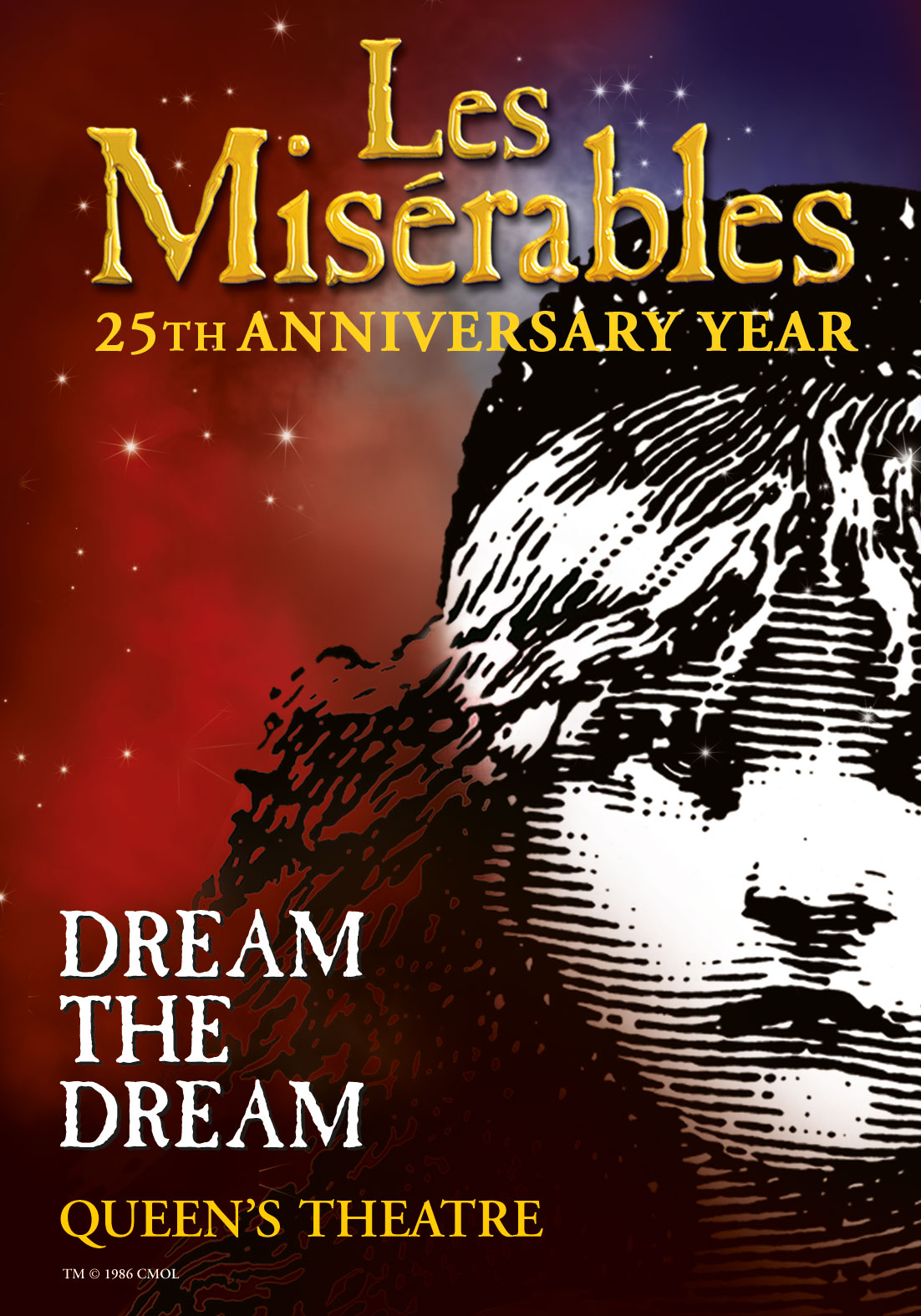
Musical
Original
22) Misérables (Les) (Original)
Joué durant 15 ans 3 mois
Nb de représentations: 10000 représentations
Première preview: 04 April 2004
Première: 12 April 2004
Dernière: 13 July 2019
Fait partie de: London Run
Compositeur: Claude-Michel Schonberg •
Parolier: Alain Boublil • Jean-Marc Natel •
Libettiste: Alain Boublil • Jean-Marc Natel •
Metteur en scène: Trevor Nunn • John Caird •
Chorégraphe: Kate Flatt •
Avec: Daniel Koek (Jean Valjean), Tam Mutu (Javert), Samantha Dorsey (Cosette), Cameron Blakely (Thenardier), Na-Young Jeon (Fantine) , Rob Houchen (Marius) Anton Zetterholm (Enjolras), Carrie Hope Fletcher (Eponine), Wendy Ferguson (Madame Thenardier).
Commentaire: After 19 years at the Palace Theatre the production was moved to the smaller Queen’s Theatre (the Palace needed considerable renovation to meet safety standards). In order to fit into the new space the scenery was reduced in size and the physical production needed shrinking. The most controversial aspect of the move was the size of the orchestra. The Palace pit accommodated 21 musicians, but the Queen’s could only hold 11. The rest of the sound was provided by a computer. The Musicians Union threatened a strike, but capitulated when Cameron Mackintosh claimed the only alternative was to close the show. The critics generally agreed that the “reduced” version had suffered no loss of richness or texture, and the new orchestral sound was perfectly satisfactory thanks to the new-fangled “Sinfonia” computer. Having now been seen by more than 50 million people in 38 countries and 21 languages, “Les Mis” had now become the most successful musical of all time. (plus)
Presse:
Plus d'infos sur cette production:
Plus d'infos sur ce musical
Parolier: Alain Boublil • Jean-Marc Natel •
Libettiste: Alain Boublil • Jean-Marc Natel •
Metteur en scène: Trevor Nunn • John Caird •
Chorégraphe: Kate Flatt •
Avec: Daniel Koek (Jean Valjean), Tam Mutu (Javert), Samantha Dorsey (Cosette), Cameron Blakely (Thenardier), Na-Young Jeon (Fantine) , Rob Houchen (Marius) Anton Zetterholm (Enjolras), Carrie Hope Fletcher (Eponine), Wendy Ferguson (Madame Thenardier).

Théâtre
21) Tamer Tamed (The) ()
Joué durant 1 mois 2 semaines
Première preview: 17 January 2004
Première: 21 January 2004
Dernière: 06 March 2004
Compositeur: *** Divers •
Parolier: *** Divers •
Libettiste: *** Divers •
Metteur en scène: Gregory Doran •
Chorégraphe:
Avec: Jasper Britton (Petruchio), Alexandra Gilbreath (Maria)
Commentaire:
Presse:
Plus d'infos sur cette production:

Théâtre
Revival
20) Taming of the Shrew (The) (Revival)
Joué durant 1 mois 3 semaines
Première preview: 14 January 2004
Première: 15 January 2004
Dernière: 06 March 2004
Compositeur:
Parolier:
Libettiste: William Shakespeare •
Metteur en scène: Gregory Doran •
Chorégraphe:
Avec: Jasper Britton (Petruchio) , Alexandra Gilbreath (Kate)
Commentaire: Shakespeare's controversial comedy plays out the war of the sexes with Petruchio's laddish wooing meets its match in Kate's spirited opposition; resulting in an hilarious battle of wills. (plus)
Presse:
Plus d'infos sur cette production:
Plus d'infos sur ce musical

Musical
Revival
19) Rocky Horror Show (The) (Revival)
Joué durant 1 semaine
Première preview: 23 June 2003
Première: 23 June 2003
Dernière: 05 July 2003
Compositeur: Richard O'Brien •
Parolier: Richard O'Brien •
Libettiste: Richard O'Brien •
Metteur en scène: Christopher Malcolm •
Chorégraphe: Stacey Haynes •
Avec: Rhona Cameron/John Stalker (Narrator), Jonathan Wilkes (Frank-n-Furter), Graham Tudor (Rocky), Jon Boydon (Brad), Katie Rowley-Jones (Janet), Neil Couperthwaite (Riff-Raff), Andrea Stevens (Magenta), Sally Hunt (Columbia), Drew Jaymson (Eddie/Dr Scott)
Commentaire: Partie de l'UK Tour connu comme le "30th Birthday Tour". (plus)
Presse:
Plus d'infos sur cette production:
Plus d'infos sur ce musical
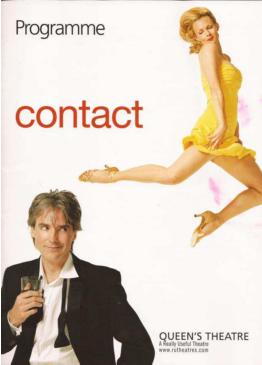
Musical
Revival
18) Contact (Revival)
Joué durant 6 mois 2 semaines
Nb de représentations: 221 représentations
Première preview: 03 October 2002
Première: 23 October 2002
Dernière: 10 May 2003
Compositeur: *** Divers •
Parolier: *** Divers •
Libettiste: John Weidman •
Metteur en scène: Susan Stroman •
Chorégraphe: Susan Stroman •
Avec: Leigh Zimmerman, Michael Praed, Sarah Wildor, Craig Urbani, Spencer Soloman, Helen Anker, Gavin Lee, Chris Jarvis, Matthew Flint, Roberto Guiffrida, Thom Graham, Dean Street, Michael Denman, Lucy Banfield, Hayley Newton, Lucy Casson, Leigh Daniels, Chris Bailey, Nathan Clarke, Candace Evans, Pip Jordon, Edward Marsdon, Gabrielle Noble, Lucy Potter, Scott Wyer.
Commentaire: Notes: This had begun in 1998 as a Lincoln Center Theatre project staging the one item “Contact”. It was expanded into a full length production and played an off-Broadway venue in October 1999. With a complete sell-out and huge praise, it was re-worked and opened in a full-scale Broadway version in March 2000, running for 1,010 performances and earning Susan Stroman a Tony Award for Best Choreography. The London production ran for six months. (plus)
Presse:
Plus d'infos sur cette production:
Plus d'infos sur ce musical
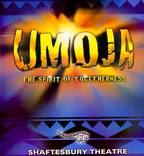
Musical
Original
17) Umoja: the Spirit of Togetherness (Original)
Joué durant 2 mois 3 semaines
Première preview: 05 June 2002
Première: 05 June 2002
Dernière: 31 August 2002
Fait partie de: London Run
Compositeur: *** Divers •
Parolier: *** Divers •
Libettiste: *** Divers •
Metteur en scène: Ian von Memerty •
Chorégraphe: ???? ???? •
Avec: Hope Ndaba, Jeannette Baholo, Siboniso Dladla, Sipho Dlamini, Xolosile Dlamini, Nontsikelelo Dipudi, Jabulile Dube, Unathi Hans, Jackie Kumbuzile, Gabisile Manana, Zwelake Mapumulo, Thulane Maqungu, Collen Mavundhla, S'Tombe Mazibuko, Mthokosize Mkhize, Bongani Mokhitli, Bonginkosi Mthembu, Thabiso Mthunzi, Thabile Mtshali, Musa Ndaba, Justin Ndhlovu, Mthokozist Ngcobo, Nonhlanhla Ngcobo, Sipho Ngwane, Benjamin Nhassavele, Lindiwe Ntuli, Cleopatra Phika, Stephen Sebatledo, Thabiso Serobanyane, Nonhle Sylvester, Israel Thabethe, Luck Thobela, Nomsu Tollie.
Commentaire:
Presse:
Plus d'infos sur cette production:
Plus d'infos sur ce musical
Parolier: *** Divers •
Libettiste: *** Divers •
Metteur en scène: Ian von Memerty •
Chorégraphe: ???? ???? •
Avec: Hope Ndaba, Jeannette Baholo, Siboniso Dladla, Sipho Dlamini, Xolosile Dlamini, Nontsikelelo Dipudi, Jabulile Dube, Unathi Hans, Jackie Kumbuzile, Gabisile Manana, Zwelake Mapumulo, Thulane Maqungu, Collen Mavundhla, S'Tombe Mazibuko, Mthokosize Mkhize, Bongani Mokhitli, Bonginkosi Mthembu, Thabiso Mthunzi, Thabile Mtshali, Musa Ndaba, Justin Ndhlovu, Mthokozist Ngcobo, Nonhlanhla Ngcobo, Sipho Ngwane, Benjamin Nhassavele, Lindiwe Ntuli, Cleopatra Phika, Stephen Sebatledo, Thabiso Serobanyane, Nonhle Sylvester, Israel Thabethe, Luck Thobela, Nomsu Tollie.
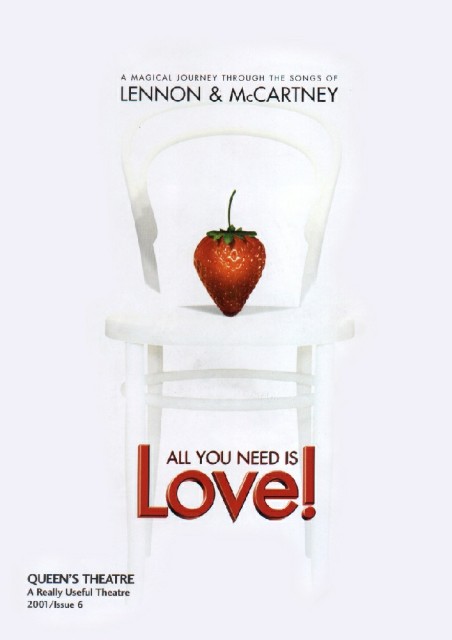
Musical
Original
16) All you need is love (Original)
Joué durant 3 mois
Nb de représentations: 111 représentations
Première preview: 21 May 2001
Première: 29 May 2001
Dernière: 01 September 2001
Compositeur: Beatles •
Parolier: Beatles •
Libettiste: Jon Miller • Pete Brooks •
Metteur en scène: Jon Miller • Pete Brooks •
Chorégraphe: Nigel Charnock • Kathy Prince •
Avec:
Commentaire: A cast of 12 perform no less than 54 Beatles songs - a kind of sung-through song-and-dance compilation, with some of the songs being given unusual interpretations - a concert rather than a musical. It lasted just 14 weeks. (plus)
Presse:
Plus d'infos sur cette production:
Plus d'infos sur ce musical
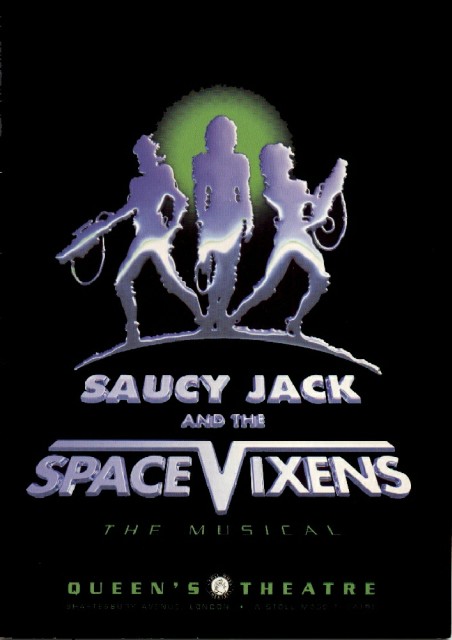
Musical
Original
15) Saucy Jack and the Space Vixens (Original)
Joué durant 2 mois 1 semaine
Nb de représentations: 85 représentations
Première preview: 18 March 1998
Première: 25 March 1998
Dernière: 06 June 1998
Compositeur: Jonathan Croose • Robbin Forrest •
Parolier: Jonathan Croose • Robbin Forrest •
Libettiste: Charlotte Mann • Michael Fidler •
Metteur en scène: Keith Strachan •
Chorégraphe: Ian Stuart-Ferguson • Chritina Avery •
Avec: David Schofield (Saucy Jack), Catherine Porter (Jubilee), Natasha Bain (Anna), Johanna Alitt (Bunny), David Ashley (Booby), Adam Meggido (Dr Whackoff), Hannah Waddingham (Chesty), Daniel Wexler (Sammy), Mark Oxtoby (Mitch)
Commentaire:
Presse:
Plus d'infos sur cette production:
Plus d'infos sur ce musical
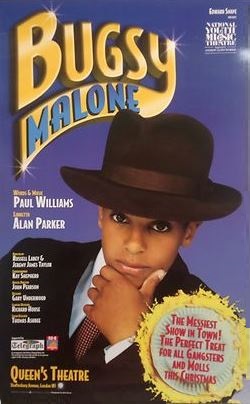
Musical
Revival
14) Bugsy Malone (Revival)
Joué durant 2 mois
Première preview: Inconnu
Première: 01 June 1997
Dernière: 01 August 1997
Compositeur: Paul Williams •
Parolier: Paul Williams •
Libettiste: Mickey Dolenz •
Metteur en scène:
Chorégraphe:
Avec: Paul Lowe, Janee Bennett, Leanne Connelly, Chris Dyer, Matt Fraser, Nana Kumi, Alex Lee, Malinda Parris, Stuart Piper, Sheridan Smith, Hannah Spearritt, Michael Sturges, and Shean Williams
Commentaire:
Presse:
Plus d'infos sur cette production:
Plus d'infos sur ce musical

Musical
Original London
13) Passion (Original London)
Joué durant 6 mois
Nb de représentations: 232 représentations
Première preview: 13 March 1996
Première: 26 March 1996
Dernière: 28 September 1996
Compositeur: Stephen Sondheim •
Parolier: Stephen Sondheim •
Libettiste: James Lapine •
Metteur en scène: Jeremy Sams •
Chorégraphe: Jonathan Butterell •
Avec: Michael Ball (Giorgio), Maria Friedman (Fosca), Helen Hobson (Clara), David Firth (Colonel Ricci), Hugh Ross (Doctor Tambourri), Michael Heath, Michael Cantwell, Simon Green, Ian McLamon,
Commentaire: Based on Ettore Scola’s film “Passione d’Amore” and the novel “Fosca”, the 1994 Broadway production won four Tony Awards and was hailed as one of the most important musicals of recent years, running for 280 performances.
This production was the samae as the Broadway Production, except there was an intermission between Scene Seven and Scene Eight, and a new song in Scene Thirteen (called "No One Has Ever Loved Me" on the London concert recording, but not the same as the similarly titled selection on the Broadway recording). It is sung after the "Farewell Letter" by Giorgio in his confrontation with Doctor Tambourri.
The London production did not fare quite so well, in spite of rave notices for Maria Friedman and excellent ones for Michael Ball. The production was described as a “chamber opera” of such intensity that it would not be to everyone’s taste, but generally was highly praised and admired. It had a six month run, though at the end of the year it did receive the Evening Standard Award as the Best Musical of the Year. (plus)
Presse:
Plus d'infos sur cette production:
Plus d'infos sur ce musical
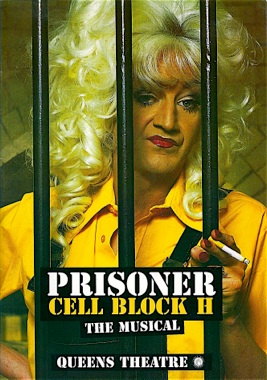
Musical
Original
12) Prisoner of Cell Block H - The Musical (Original)
Joué durant 2 mois 2 semaines
Nb de représentations: 88 représentations
Première preview: 23 October 1995
Première: 30 October 1995
Dernière: 13 January 1996
Compositeur: *** Divers •
Parolier: *** Divers •
Libettiste: *** Divers •
Metteur en scène: David McVicar •
Chorégraphe: Peter Titus •
Avec: Lily Savage (Herself), Maggie Kirkpatrick (Joan Ferguson), Penny Morrell (The Governor), Liz Smith (Minnie), Alison Jiear (Mrs Austin), Sara Stephens (Patsy), Terry Neason, Emma Kershaw, Jeffrey Perry.
Commentaire: The cult Australian TV soap set in a women’s prison was re-created as a camp musical which dispensed with any seriousness, kept the wobbly sets and daft plot, added some witty songs, and ended up as a gloriously hilarious show for some critics - and as a complete load of tacky amateurish rubbish for others. Liverpool’s own Lily Savage (Paul O’Grady) has been wrongly jailed for prostitution, theft and murder whilst on holiday Down Under - accused of stealing a fondue set. Joan “ the Freak” Ferguson (from the original TV cast) is a leather-clad jackbooted prison warder with a compulsive fondness for strip-searching the prisoners. British actress, Liz Smith, plays a mad old lady doing bird pottering around in a dishevelled and confused state. Such plot as there was involved Joan Ferguson attempting to poison the Governor’s tea in order to take over control of the prison to show the prisoners some “real discipline” (plus)
Presse:
Plus d'infos sur cette production:
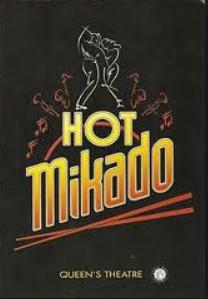
Musical
Original
11) Hot Mikado (Original)
Joué durant 2 mois 3 semaines
Nb de représentations: 101 représentations
Première preview: 18 May 1995
Première: 24 May 1995
Dernière: 19 August 1995
Compositeur: Rob Bowman •
Parolier: David H Bell •
Libettiste: David H Bell •
Metteur en scène: David H Bell •
Chorégraphe: David H Bell •
Avec: Sharon Benson (Katisha), Lawrence Hamilton (The Mikado), Paul Manuel (Nanki-Poo), Ross Lehman (Ko-Ko), Richard Lloyd King (Pooh-Bah), Veronica Hart (Peep Bo), Paulette Ivory (Yum-Yum), Alison Jiear (Pitti-Sing), Neil Couperthwaite (Junior)
Commentaire: The production had been a success in Washington and other US cities (though it had not played Broadway) and came to London with some of the original cast. However it failed to catch on in the West End and closed after 12 weeks. (plus)
Presse:
Plus d'infos sur cette production:
Plus d'infos sur ce musical
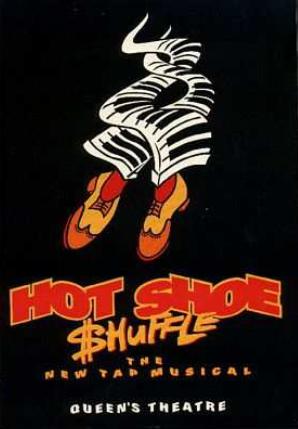
Musical
Original
10) Hot Shoe Shuffle (Original)
Joué durant 5 mois
Nb de représentations: 175 représentations
Première preview: 22 March 1994
Première: 22 March 1994
Dernière: 20 August 1994
Compositeur: *** Divers •
Parolier: *** Divers •
Libettiste: *** Divers •
Metteur en scène: David Atkins •
Chorégraphe: David Atkins • Dein Perry •
Avec: David Atkins, Dean Perry, Kevin Coyne, Christopher Horsey, Sheldon Perry, Dale Pengelly, Adam Garcia, Rhonda Burchmore, Jack Webster
Commentaire: Seven brothers and their newly discovered sister must learn their late father’s tap-dancing routines in order top inherit millions. Starting off comically bumping into each other a lot, and ending up dancing with tremendous vitality and flair - the show is an excuse for a song and dance exhibition “which a generation ago would have been a speciality act in a revue and is now elevated to an entire evening’s entertainment.”
1995 Olivier Award Winner - Best Choreography (plus)
Presse:
Plus d'infos sur cette production:
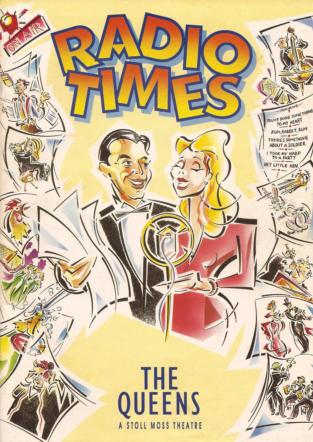
Musical
West End Transfer
9) Radio Times (West End Transfer)
Joué durant 3 mois
Nb de représentations: 108 représentations
Première preview: Inconnu
Première: 15 October 1992
Dernière: 16 January 1993
Compositeur: *** Divers •
Parolier: *** Divers •
Libettiste: *** Divers •
Metteur en scène: David Gilmore •
Chorégraphe: Anthony Van Laast •
Avec: Tony Slattery (Sammy Shaw), Peter Rutherford (Heathcliffe Bultitude), Kathryn Evans (Olive), Jeff Shankley (Gary Strong), James Buller (Jeeps), Amy Chapman, Wilfred Davies, Tamzin Outhwaite, Martin Eyre, Linda Mae Brewer
Commentaire: Following a try-out at Birmingham Rep, this show came into London on the skirts of the hugely successful “Me and My Girl”. With its total emphasis on nostalgia the older critics loved it, while the younger ones were mystified. It ran for three months. (plus)
Presse:
Plus d'infos sur cette production:
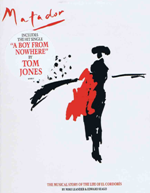
Musical
Original
8) Matador (Original)
Joué durant 3 mois 1 semaine
Nb de représentations: 119 représentations
Première preview: 16 April 1991
Première: 16 April 1991
Dernière: 27 July 1991
Compositeur: Michael Leander •
Parolier: Edward Seago •
Libettiste: Peter Jukes •
Metteur en scène: Elijah Moshinsky •
Chorégraphe: Arlene Phillips •
Avec: John Barrowman (Domingo Hernandez), Stefanie Powers (Laura-Jane Wilding), Nicky Henson (El Panama), Jackie Dunn (Graciella), Caroline O’Connor (Consuelo), Alexander Hanson (Tomas), Kevin A.J. Ranson (Miguel), Franciso Perez Arevalo (The Bull)
Commentaire: Based on “Or I’ll Dress You in Mourning”, the biography of the Spanis bullfighter El Cordobés by Larry Collins and Dominique Lapierre, this show began as a concept album recorded by Tom Jones in 1987. Originally Tom Jones was planned to star in a stage version, but this did not work out, and his role was taken by John Barrowman.
The show had spectacular sets and superb flamenco dancing, and everyone agreed it was one of the best dance shows ever seen on the London stage. However, with animal rights protesters outside the theatre each night claiming the show glorified bullfighting, the controversy surrounding the show did not help. Neither did a much derided scene in which the matador and bull sing a duet in which they declare that they have much in common, both being trapped, exploited and destined for death. It closed after three months with losses of around £1 million. (plus)
Presse:
Plus d'infos sur cette production:
Plus d'infos sur ce musical
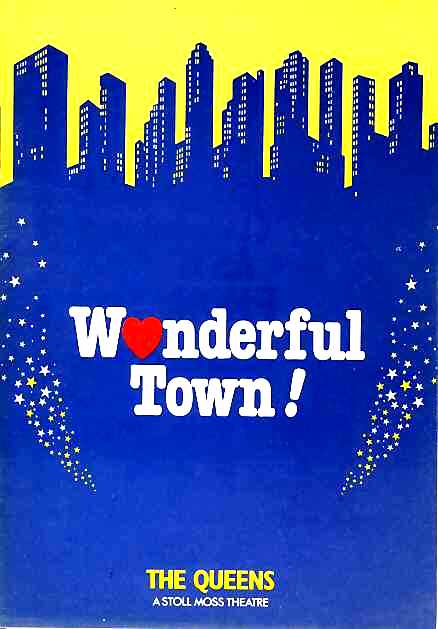
Musical
Revival
7) Wonderful Town (Revival)
Joué durant 7 mois 3 semaines
Nb de représentations: 267 représentations
Première preview: 07 August 1986
Première: 07 August 1986
Dernière: 28 March 1987
Compositeur: Leonard Bernstein •
Parolier: Adolph Green • Betty Comden •
Libettiste: Jerome Chodorov • Joseph Fields •
Metteur en scène: Martin Connor •
Chorégraphe: David Toguri •
Avec: Maureen Lipman (Ruth Sherwood), Emily Morgan (Eileen Sherwood), Ray Lonnen (Robert Baker), Nicolas Colicos (Wreck) Lesley Joseph (Violet), Michael Fitzpatrick, Angela Moran, John Cassadt, Roy Durbin, Ted Merwood, Ben Stevens
Commentaire: This production originated at the Palace Theatre, Watford. (plus)
Presse:
Plus d'infos sur cette production:
Plus d'infos sur ce musical

Théâtre
Revival
6) Hay Fever (Revival)
Joué durant 1 semaine
Première preview: Inconnu
Première: 18 October 1983
Dernière: 25 October 1983
Compositeur:
Parolier:
Libettiste: Noël Coward •
Metteur en scène:
Chorégraphe:
Avec: Penelope Keith as 'Judith Bliss' with Moray Watson as 'David Bliss', Rosalyn Landor as 'Sorel Bliss', Mark Payton as 'Simon Bliss', David Delve as 'Sandy Tyrell', Susan Bovell as 'Myra Arundal', Donald Pickering as 'Richard Greatham', Abigail McKern as 'Jackie Coryton' and Elizabeth Bradley as 'Clara'
Commentaire:
Presse:
Plus d'infos sur cette production:
Plus d'infos sur ce musical
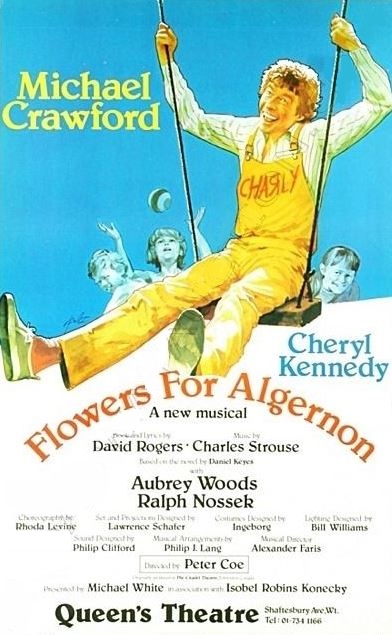
Musical
Original
5) Charlie and Algernon (Original)
Joué durant
Nb de représentations: 29 représentations
Première preview: Inconnu
Première: 14 June 1979
Dernière: Inconnu
Compositeur: Charles Strouse •
Parolier: David Rodgers •
Libettiste:
Metteur en scène: Peter Coe •
Chorégraphe: Rhoda Levine •
Avec: Michael Crawford (Charlie Gordon) , Betty Benfield, Aubrey Woods, Ralph Nossek, Jason Ash, Jeanna L’Esty,
Commentaire: Based on the novel by Daniel Keyes. The musical was first produced in Canada in December 1978 before its London premiere. A much talked-of scene had Michael Crawford singing one number in a spotlight while a trained white mouse ran from one of his hands to the other, by way of Crawford's shoulders and neck. (This was a trick he would repeat 24 years later in a completely different musical, “The Woman in White”). Despite the enormous popularity of Michael Crawford, the show was disliked by critics and public alike, and came off after 29 performances. A Broadway production, re-named “Charlie and Algernon”, opened in September 1980 and ran for just 17 performances, though it did receive a Tony nomination for Best Score. (plus)
Presse:
Plus d'infos sur cette production:
Plus d'infos sur ce musical
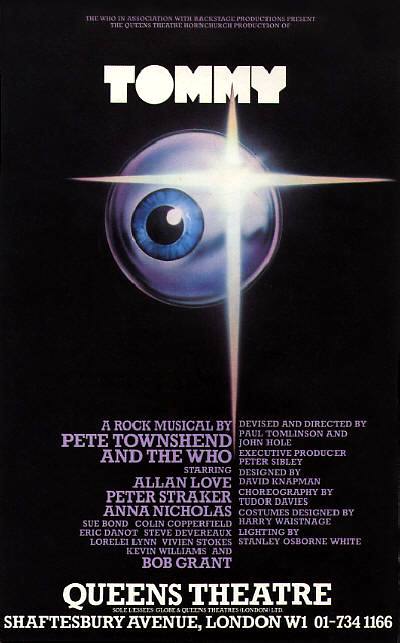
Musical
Original
4) Tommy (Original)
Joué durant
Nb de représentations: 118 représentations
Première preview: Inconnu
Première: 06 February 1979
Dernière: Inconnu
Compositeur:
Parolier:
Libettiste:
Metteur en scène: Paul Tomlinson •
Chorégraphe: Tudor Davies •
Avec: Allan Love (Tommy), Anna Nicholas (Acid Queen), Peter Straker (Narrator), Kevin Williams (Cousin Kevin), Sue Bond (Nurse), Steve Devereaux (Lover), Bob Grant (Uncle Ernie)
Commentaire: This was the first West End stage presentation of the smash-hit 1967 recording. A concert version was given at the Rainbow Theatre in 1972, a stage version had played in America, and Ken Russell directed a film version starring Roger Daltrey in 1975. That same year a fully-staged production was produced at Derby Playhouse. An expanded version was staged by the Queen’s Theatre, Hornchurch in 1978 and it was this latest version that came into London. However, with its confused messages of biblical and rock-drug references, and the absence of its original pop heroes, it received poor notices and managed just a three month run. (plus)
Presse:
Plus d'infos sur cette production:
Plus d'infos sur ce musical

Musical
Revival
3) Hair (Revival)
Joué durant
Première preview: 01 June 1974
Première: 01 June 1974
Dernière: Inconnu
Compositeur: Galt MacDermot •
Parolier: Gerome Ragni • James Rado •
Libettiste: Gerome Ragni • James Rado •
Metteur en scène:
Chorégraphe:
Avec:
Commentaire:
Presse:
Plus d'infos sur cette production:
Plus d'infos sur ce musical
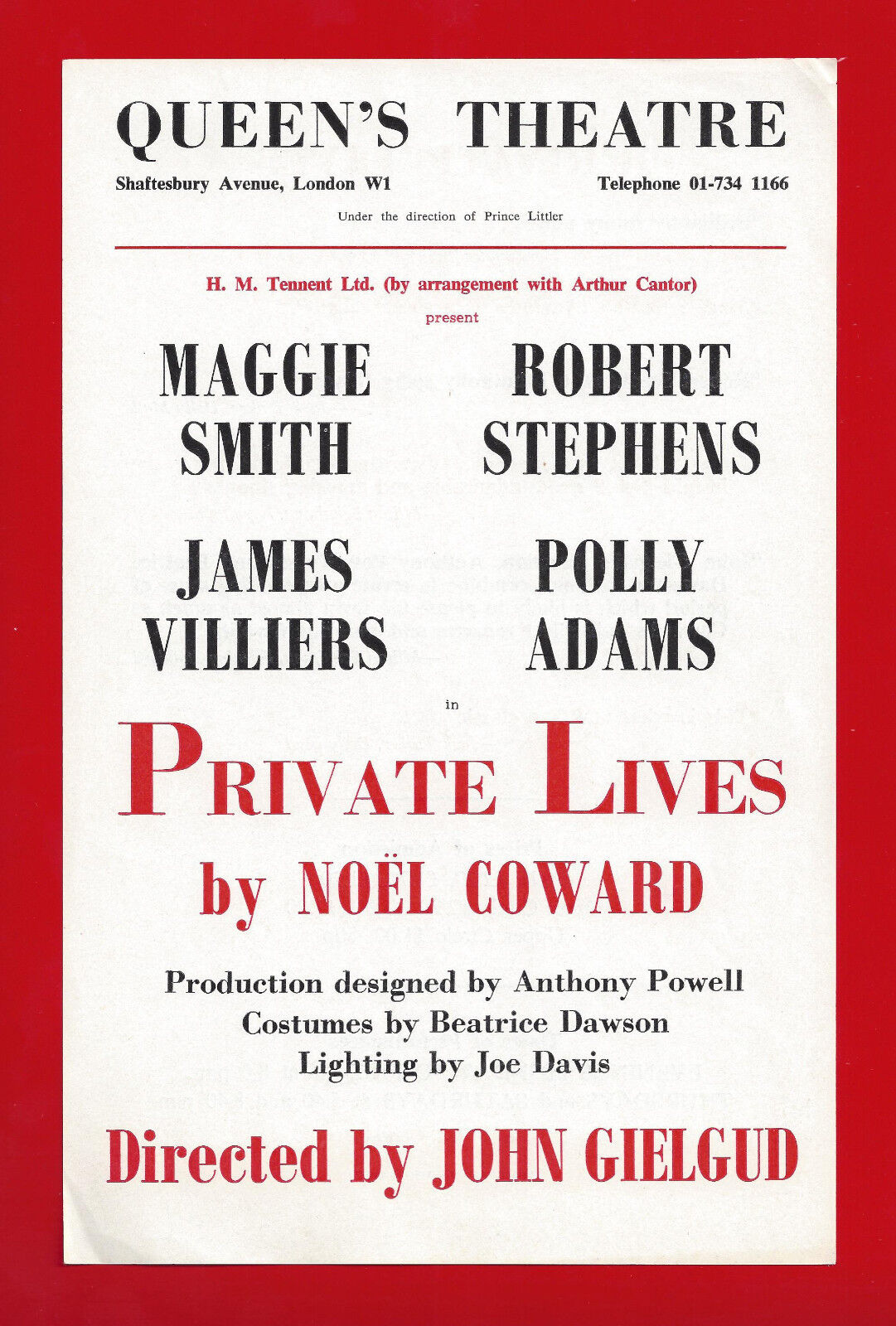
Théâtre
Revival
2) Private lives (Revival)
Joué durant 1 an 4 mois 1 semaine
Première preview: 21 September 1972
Première: 21 September 1972
Dernière: 26 January 1974
Compositeur:
Parolier:
Libettiste: Noël Coward •
Metteur en scène: John Gielgud •
Chorégraphe:
Avec: Maggie Smith (Amanda Prynne), Robert Stephens (Elyot Chase), Cari Hedderwick (Louise (a Maid)), Polly Adams (Sibyl Chase), James Villiers (Victor Prynne), John Standing (Elyot)
Commentaire: Queen's Theatre (Sondheim Theatre): 21/9/1972 - 6/1973
Globe Theatre (Gielgud Theatre): 2/7/1973 - 26/1/1974 (plus)
Presse:
Plus d'infos sur cette production:
Plus d'infos sur ce musical



.png)
.png)





